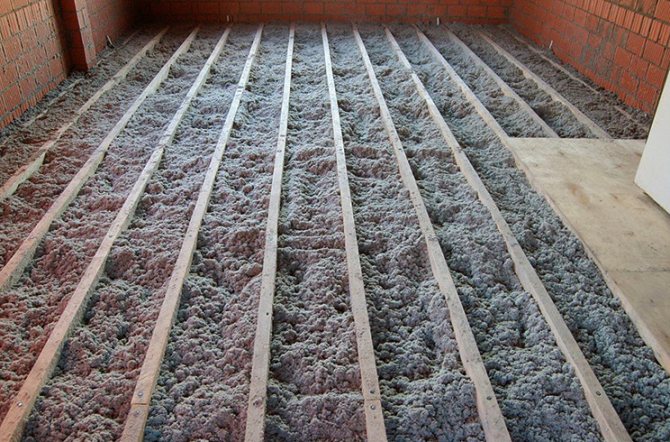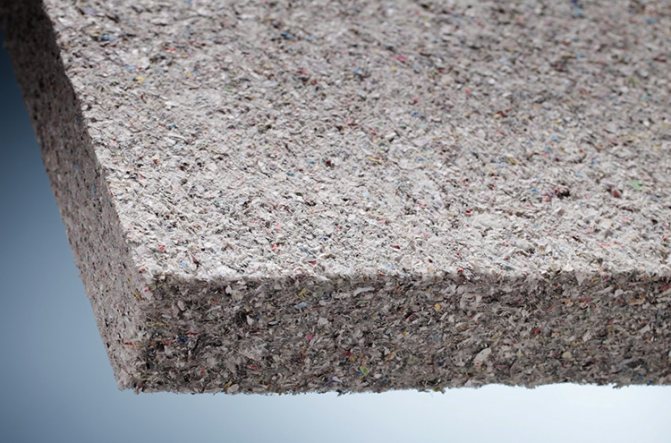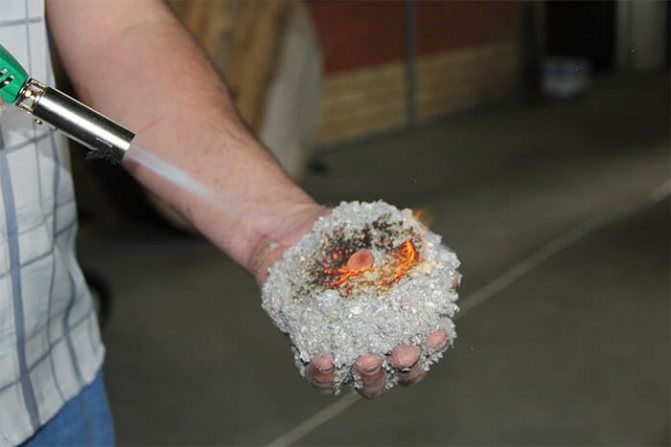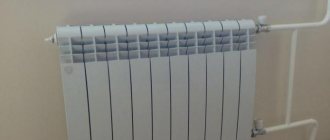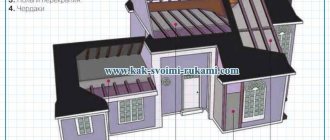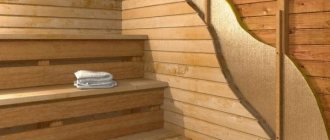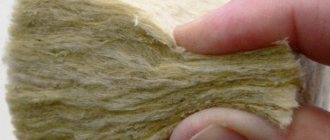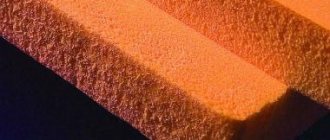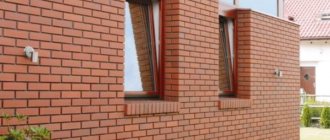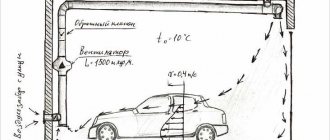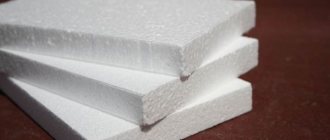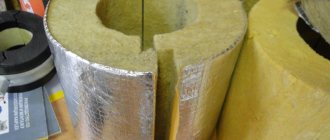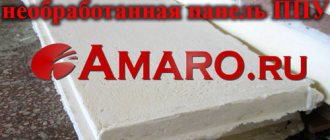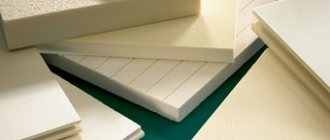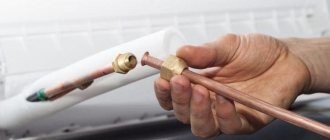Before anyone who builds or plans to build a frame house, the question of choosing a sound and heat insulation material is sure to arise. Many good materials are available today, but this variety can confuse the untrained builder. Nevertheless, the choice of insulation must be approached with all responsibility and knowledge of the matter, because mistakes in its choice and inaccuracies in laying can negate many of the advantages of a new frame house. Some of the most popular thermal insulation materials are ecowool and mineral wool. To determine which one is better, it is necessary to consider the features, advantages and disadvantages of each option.
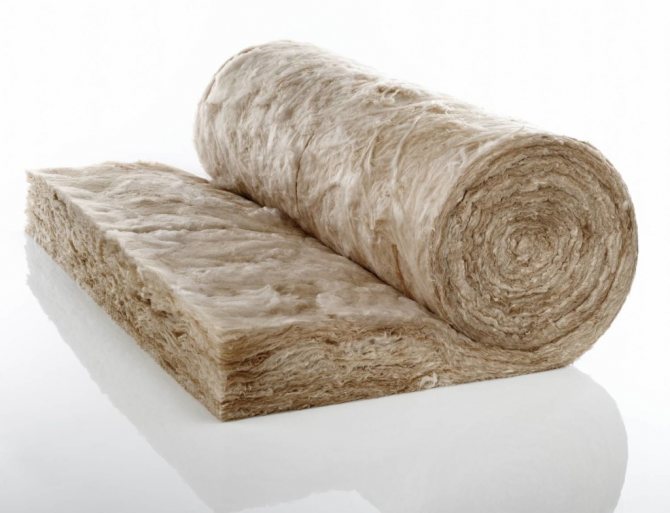
Mineral wool can be in rolls, mats and slabs.
Ecowool: the main advantages and characteristics Ecowool is a very good material with which you can create reliable and effective thermal insulation. The material itself is approximately 80% cellulose fibers. It does an excellent job of organizing thermal insulation and has the right mechanical properties to create a uniform, seamless layer. However, cellulose itself is not used in construction, as it is highly flammable and subject to destruction under the influence of various biological factors. To eliminate these shortcomings, ecowool contains auxiliary substances: borax and boric acid.
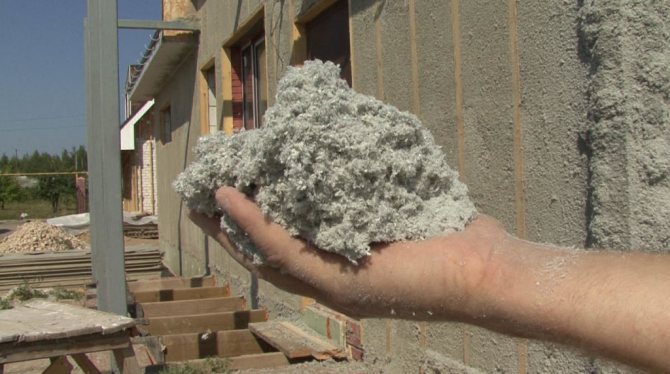

Ecowool is safe in production, installation and operation.
Borax is an excellent fire retardant, i.e. it reduces the fire hazard. As a result, ecowool is a material with a fire safety level of G2. Of course, it cannot be used to insulate heating boilers and chimneys, but this material is better suited for roofs, walls and interfloor ceilings than many others. Boric acid provides the cellulose with long-lasting and optimal protection against fungus, rot and rodent attack. Oddly enough, such a combination provides significantly more effective protection against rodents than the same mineral wool, which is very attractive to them. As a result, it turns out that ecowool has the following main characteristics:
- thermal conductivity coefficient - 0.037-0.042 W / mK;
- flammability group G2, according to which the material does not ignite;
- the density during laying can vary from 26 to 95 kg / m3;
- vapor permeability 0.3 mg / (mchPa).
Compared to such popular heat-insulating materials as basalt slabs, mineral wool or expanded polystyrene, modern ecowool does not fundamentally stand out, but it is not inferior to them either. But she has a number of pronounced advantages that give her the opportunity to become indispensable in the construction of frame houses and an excellent insulation in any other case:
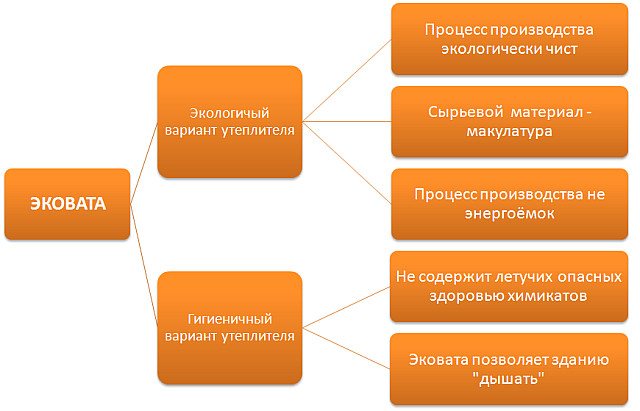

The advantages of ecowool as insulation.
- absorption and evaporation of moisture. Along with a low value of vapor permeability and air permeability, ecowool still absorbs water to a large extent. However, unlike the same mineral wool, it is capable of absorbing a fairly large amount of liquid without a significant deterioration in thermal insulation properties. With an increase in humidity by only 1%, mineral wool adds about 8-9% in thermal conductivity, while ecowool, even in the case of an increase in humidity by only 25%, will lose no more than 5% in the coefficient of thermal conductivity;
- in addition to this, it is necessary to take into account the properties of cellulose, which is capable of both absorbing moisture and giving it back without any negative consequences for itself. So, ideally, in the case of using ecowool in a frame wooden house, it will help maintain the humidity of the air inside the room within the limits of comfort for human life. For normal and efficient operation of ecowool, suitable conditions must be created under which excess moisture will be removed from the heat insulator. Otherwise, it will simply be oversaturated with moisture. For this reason, it is not recommended to use ecowool when insulating ceilings over basements and basements, in which there is a consistently high level of humidity;
- seamlessness of thermal insulation. Ecowool is a loose homogeneous mass. Installation of insulation can be performed even in the simplest version - in bulk into prepared frame cells inside ceilings or on walls. As a result, a seamless layer of insulation will be obtained, which, subject to high-quality installation, completely fills the entire volume allocated for the insulating material. It turns out that there is no chance of the formation of voids that worsen thermal insulation, or cold bridges;
- soundproofing. The air permeability of this material is much lower than that of mineral wool, while it is elastic and easily absorbs any sound waves, unlike other popular insulating materials. All this allows ecowool to provide much more effective protection of indoor spaces from external sounds and noise;
- safety and environmental friendliness. Ecowool contains no phenolic binders that are harmful to health. Only natural lignin is used as a sticky substance, so there simply cannot be any fumes harmful to humans. Boric acid and borax do not evaporate or fly away, so they are completely safe.
Minvata
Mineral wool is one of the most common types of insulation for insulating various elements of a building, that is, the insulation is laid in the roof, interfloor and interior ceilings, floor, walls both inside and outside the room. Tiled or rolled mineral wool allows you to quickly insulate a house, a bathhouse, various utility and non-residential premises.
Such popularity of mineral wool is easily explained by a wide selection of varieties, brands, and availability in retail chains. Also, low cost, ease of installation, high heat and sound insulation characteristics. But there is another side - a negative one, which sometimes outweighs all the positive qualities of many varieties and brands of mineral wool. The use of formaldehyde resins as a binding component to form an insulating layer significantly reduces its environmental friendliness, but a decrease in the component reduces the moisture resistance of the finished insulating material. Only a few species based on basalt fiber do not contain harmful toxins. In its pure form, mineral wool is difficult to give the required density, there is a risk of dust from mineral fibers entering the air of the room to be insulated, therefore it is produced mainly in rolls or mats with already formed density and rigidity.
Types and form of production of ecowool
Ecowool today is presented in two forms for delivery - these are bags and pressed rolls. Cotton wool is packed in bags weighing 15 kg, in rolls - with a density of 110 kg / cubic meter. Regardless of how the ecowool was purchased - in bags or rolls - it must be thoroughly fluffed before use. Before use, the insulation should increase in volume by 3-4 times.
There are several types of ecowool, where the ways of using the material are taken into account. In this case, the types of insulation are presented as follows:
- Dry - used only for dry spraying, which will be discussed in more detail below.
- Sprayable - cotton wool is mixed with water and used for wet laying in places. It is used mainly for cladding walls that are not intended for living - hangars, warehouses, production facilities.
- Stabilized - cotton wool with less material consumption, used for dry or wet spraying.
- With oil - used for cladding residential buildings. A small amount of oil is added to the cotton wool, which reduces the amount of dust during operation.
When choosing a type of material for work, it is necessary to take into account the subsequent method of blowing in ecowool.
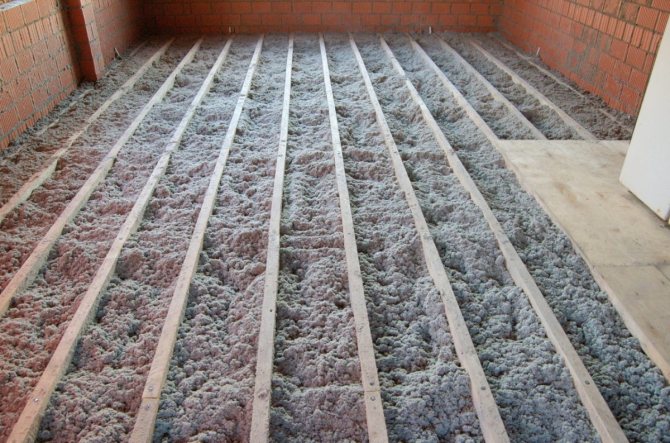

Disadvantages of tile and roll insulation
Yes, rolled and tile mineral wool is convenient for installation - they rolled out a roll or marked a plate, cut off the desired piece of a given size and insulated the available cavity. But the ease of installation is not the parameter that should be guided when choosing a heater. When cutting a roll of insulation, waste is inevitable, consumers overpay in advance for the surplus that still has to be disposed of.
Mineral wool is intended for insulating buildings made of various materials with different number of storeys and of various types, but when auditing its installation with a thermal imager or when opening it, dispersed joints and a loose fit are often found, and these, as a rule, are drafts and cold islands - the main reasons for the dampness of the insulation and , accordingly, loss of thermal insulation qualities. For this reason, mineral wool loses about 40% of its heat-saving properties already in the first years. And not always the reason for this is poor-quality installation. Subsidence of mats causes moistening, destruction of fragile stone fibers by ice crystals. And when the process is running: moistening - destruction - subsidence - the situation is getting worse every season. In such a house, keeping warm will be very, very costly, and do not forget that mice and rats in the mineral wool settle comfortably.
But there is an alternative that belatedly appeared on the Russian construction market in the 90s after it conquered low-rise construction in neighboring Europe and many more distant countries.
Ecowool
It's time to think about what influence we, willingly or unwillingly, have on the world around us and on ourselves and on our loved ones. Therefore, construction companies in Europe and the West are concerned not only with how to build a house at the lowest cost, but also strive to use environmentally friendly materials in construction. The demand from consumers of construction services for safe materials has also grown. Many are willing to overpay, but live in a clean environment at home and not pollute the surrounding space. This is the choice of modern man. There is no need to overpay for ecowool, as well as to doubt its environmental friendliness. Definitely a budget option available to many, but guaranteeing safety, energy conservation and care for natural resources.
Ways of applying ecowool
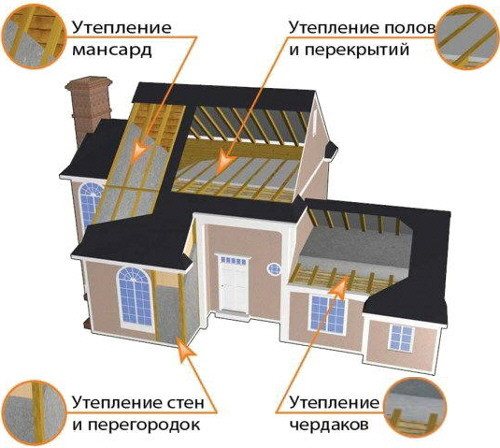

Ecowool can be used in the most inaccessible places.
There are wet and dry methods for applying ecowool. So, in the wet process, lignin is used as an adhesive. The moistened material easily adheres to the walls of any building material, forming a layer of insulation with a density of 50 to 65 kg / m³. This option is well suited for insulating block brick buildings. It is enough to carry out the lathing of the walls using a wooden bar or a metal profile, and apply the material using special equipment. The fluffed cotton wool is moistened with a small amount of water directly at the nozzle outlet and is supplied under pressure to the surface to be insulated. This installation method is the easiest to use and most productive.
For application on suspended structures, complex surfaces and when insulating ceilings from below, adhesives are additionally added to the water for moistening, which will enhance the adhesion of ecowool, except for lignin. Any surplus insulation material is cut at the level, dried and can be reused. Actually, with any method of installation of this material available today, there is no waste, because it can be reused.
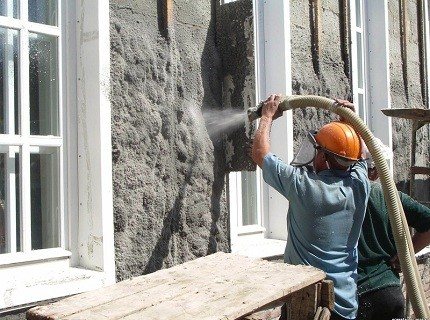

Wet spraying is used for thermal insulation of vertical surfaces.
As a classic option, the material can fill the prepared lathing cells along the ceilings and niches in the walls in a dry form. In this case, ecowool must be dried using a drill and a nozzle for stirring solutions in a bulk plastic container and fill all the necessary places in bulk. It is enough to tamp the material until it begins to absorb the forces.
For vertical distribution, the density is selected equal to 65 kg / m³, for horizontal distribution - 45 kg / m³. The industrial method of distribution of ecowool involves the injection of fluffed insulating material with a compressor. The lathing must be completely covered with foil, sheathing material or kraft paper. A hole must be made at the top of the structure to install the supply hose. Under the influence of air flow and pressure, material is blown into all, even insignificant, recesses of the cell to the top. When filling is complete, the hole is closed. Ecowool: material flaws
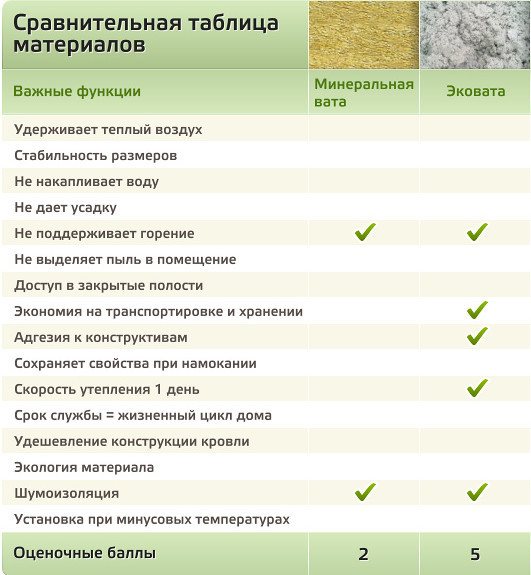

Comparative characteristics of materials.
In fact, the main disadvantage of ecowool is that additional equipment must be used for its convenient and most efficient installation. Moreover, it will be needed not only when carrying out wet insulation, but also when dry, it will also be very useful. In addition, sufficient skilled workers are needed to lay the material. Drying time for wet mounting is 2-3 days, and sometimes there is simply no way to wait.
The features and technical characteristics of ecowool described above show that it is no worse than any other common materials for thermal insulation. In addition to this, this material is highly durable and environmentally friendly. The use of technological equipment makes it possible to insulate a room or building of any shape or volume in the shortest possible time. Considering the low cost of the material itself, the unpretentiousness of the equipment used and the waste-free installation, insulation work using ecowool will cost less than using any other similar insulating materials. When performing manual installation, the consumption of material increases significantly, but the total cost still remains relatively low.
Minvata: features and advantages of material Minvata is a fibrous material, the structure of which depends on what type of raw material was used for its production. The structure of the material is set technologically and can be of several different types, namely: horizontally layered, vertically layered, corrugated, spatial. The presence of these types of fiber allows the use of this insulating material in structures of a wide variety of types.
Minvata has many advantages and positive characteristics compared to other popular insulating materials, namely:
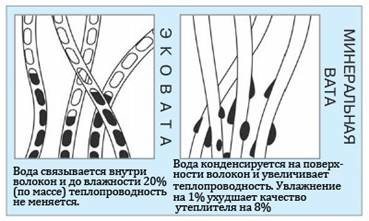

Ecowool absorbs moisture well.
- thermal conductivity is the most significant indicator.Mineral wool has a thermal conductivity of 0.039-0.045 W / mK, which is one of the best indicators among this kind of insulation and provides high energy efficiency when using it;
- high resistance of the material to open fire and high temperatures;
- good resistance to all kinds of aggressive chemicals;
- the sound-absorbing characteristics of the mineral wool make it possible, along with the insulation of the premises, to solve the issues of sound insulation;
- some varieties of mineral wool have quite good strength qualities and are able to withstand a static load normally. This indicator is reflected in the duration of the service life, because the less the deformation of the insulating layer, the longer its service life;
- the material's ability to pass vapors makes it possible to ensure the natural "breathing" of the walls and prevents the formation of fungi, mold and corrosive processes;
- the environmental friendliness of mineral wool lies in the fact that the process of its production takes about 100 times less energy resources than their savings over the period of operation.
In mineral wool there are no conditions for the formation of convection: although microcavities are open, they are too small, and the air gets stuck in them due to its own viscosity, therefore direct heat transfer through the mineral wool is insignificant, but its price is relatively low. However, health hazards from openly laid mineral wool are common knowledge. In addition, from a constant vertical load, albeit insignificant, mineral wool falls and loses its heat-insulating characteristics. Mineral wool absorbs moisture quite intensively and at the same time also falls off.
Nevertheless, due to its low cost, durability and resistance to external influences, this material is often used to organize the thermal insulation of residential premises. There are cases when instead of mineral wool, only more expensive material, such as vermiculite, can be used. In such cases, most developers prefer mineral wool. How is floor insulation done with mineral wool?
Floor construction
Insulation of floors in residential premises with mineral wool is carried out with special mats, roll or sheet, or plates, covered on one or both sides with a metallized film or aluminum foil. Warming with open blocks of mineral wool is permissible only in non-residential premises or from the basement side. However, aluminized material still has a number of important advantages with an insignificant increase in its cost. Each layer of metal is a highly efficient heat shield.
One layer of mineral wool, aluminized on 2 sides, almost completely eliminates heat transfer by radiation. As a result, the combination of re-reflection of infrared radiation from the screens with absorption in the mineral wool array equalizes the temperature gradient in the insulation material. Putting 3 layers, you can forget about the existence of the dew point. Aluminized mineral wool, subject to the technology and the rules of its laying, does not require a separate vapor barrier. Mats made of aluminized mineral wool are thinner than open ones - from 0.6 cm, so in some cases they can be used without lathing. Mineral wool should be installed with protective gloves and a petal respirator.
Under the floating floor made of cork (marmoleum), mineral wool is laid in a continuous layer, and between the logs, it is desirable to have a lathing device in the size of the cell. The edges and joints of the plates must be carefully glued with special tape: this will help prevent microneedles from entering the air of the insulated room, which are harmful to the respiratory system. Over time, the scotch tape, of course, will weaken, however, the mineral wool will stop peeling off. Minvata - universal insulation
Comparison of materials for fire resistance.
The area of use of mineral wool - a completely universal insulation - is quite wide. The material is produced in 2 main forms: mats in the form of rolls and mineral wool boards of various fixed sizes. The fibers of the material themselves are able to withstand temperatures up to + 700 ° C, however, for phenol-formaldehyde resins, which are used as a binder, the degradation process begins at a temperature of + 300 ° C, and the fibers begin to crumble.
So, where can mineral wool be effectively used:
- for the installation of one of the layers of thermal insulation (upper or lower) - the so-called. roofing cake or independent thermal insulation of pitched and flat roofs;
- for thermal insulation of industrial heating, water supply and pipeline networks, equipment and tanks;
- in the manufacture of three-layer reinforced concrete structures and sandwich panels;
- in the form of an unloaded heat-insulating layer in all types of building structures;
- for external wall insulation with plastering, etc.
The technology of using mineral wool requires a mandatory device for moisture and vapor barrier. Summing up, we can conclude that ecowool is a more preferable material in terms of health safety, but more expensive and more difficult to install.
What is ecowool
Remembering that suburban construction in Russia began to actively develop from the earliest times, then in St. Petersburg and the Leningrad region ecowool appeared relatively recently. Acquaintance with Ecowool in the low-rise suburban construction of St. Petersburg began in unfavorable conditions for her: it was not clear with the supply of cellulose insulation, not to mention equipment for installing ecowool, although in Europe it was used even in the pre-war period. But even in our time we still have to hear from construction crews, behind whose shoulders there is more than one erected country house: EKOVATA - and what is it?
Ecowool is an environmentally friendly material that consists entirely of natural ingredients:
- borax - 7%;
- boric acid - 12%;
- recycled cellulose - 81%.
The loose consistency of ecowool allows for seamless installation, after which there will be no drafts, mice and insects in the house. There is no problem with leftovers - there is no waste during installation, every gram of ecowool will reliably protect your home.
What the insulation consists of and where is it used
Ecowool is a heat insulator, which is made from various waste paper and paper industry waste together with fire retardants and other antiseptics, forming a natural product with a capillary structure. Several types of raw materials are used in the production.
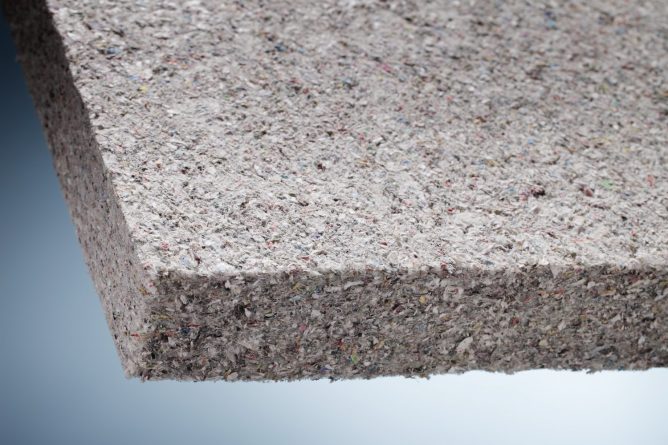

Remains of cardboard and paper industrial production:
- Discarded book and magazine products.
- Waste generated during the production and trimming of the corrugation.
- Defective and redundant components of cardboard production.
Or second-rate raw materials, in the form of old magazines, books, newspapers and other waste paper, which is excessively dirty, having a lower quality.
In general, 80% of the composition of ecowool includes cellulose fibers, which are produced from recycled materials. 12% is boric acid, which is an organic antiseptic, which protects the heat insulator from the negative effects of numerous fungal and bacterial organisms. The remaining volume is filled with sodium tetraborate, which reduces the level of flammability and combustibility of the material. During the manufacturing process, the fibers are wetted, becoming sticky, due to the lignin being deposited.
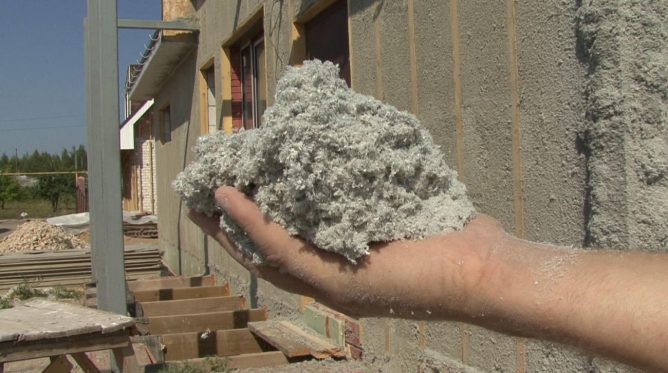

The area of using ecowool is quite extensive. It is used as a heater in the decoration of residential and industrial buildings, office and warehouse premises and other types of buildings.It is beneficial to use this heat insulator in buildings that are constantly amenable to moisture and have a high level of potential condensation.
Rid the house of rodents and insects
To permanently protect your house from the invasion of rats and mice, as well as insects, you do not need to use poisonous chemicals - just insulate the house with ecowool, and these uninvited guests will lose interest in your home.
The fact is that both insects and rodents cannot live near ecowool in any way - they cannot tolerate the borates that are in its composition. Boric acid and its salts are not volatile, resist fire, and are safe for humans. Therefore, the use of cellulose insulation allows you to solve a number of important problems:
- increasing thermal insulation;
- increasing sound insulation;
- protecting the house from rats and insects;
- protection against drafts;
- natural regulation of humidity at home;
- lack of mold and mildew.
How to use
Ecowool is thermal insulation of walls and sound insulation of the entire room. Ecowool is used as a heat-insulating material in the following cases:
- in the construction of apartment buildings and private in the formation of floors;
- insulation in all frame structures;
- for warm plaster;
- for multi-layer wall insulation;
- for the reconstruction of an old building.
Since wall insulation is only one of the ways to use ecowool, the following insulation options are distinguished:
- it is recommended to use insulation as a sound-insulating material in the construction of apartment buildings and private ones in ceilings and walls;
- ecowool is used as part of sound-absorbing plaster;
- in any partition walls.
It should be noted that roof insulation with ecowool is used both to increase heat and sound absorption. There are two ways to use the considered insulation - wet and dry.
Wet way Is an industrial method that uses a special blowing machine for spraying ecowool. Recommended for use on brick or block walls. In the process of work, a dense layer is formed - about 60 kg / cubic meter. The material is pre-wetted with water or a special adhesive lignin. The application method is fast, but there is a drawback in the form of the obligatory use of expensive blowing equipment for blowing ecowool.
Dry method - This is a manual method of wall and roof insulation, where cotton wool is laid out by hand or by a compressor. A method is used to insulate or improve sound insulation of small buildings, including private houses. The material is preliminarily fluffed with a drill with a nozzle for a solution until the volume increases by 3-4 times, as mentioned above.


Maintaining humidity in the house
This property of ecowool is well known - the natural regulation of humidity in the house. The process is ensured due to the properties of the insulation: it accumulates moisture when there is an excess in the air and gives back moisture when it is lacking, for example, during the heating season. By the way, ecowool absorbs moisture into itself, that is, moisture is absorbed into the fibers themselves, leaving the air between the cellulose fibers minimally moist, unlike mineral wool, (if we return to the question: which is better - ecowool or mineral wool), and humid air is a conductor cold.
Characteristics and properties of ecowool
Ecowool has the following properties:
High thermal insulation
Compared to basalt wool, the efficiency of ecowool is 24% higher. The technology of applying the material ensures the filling of any cavities, excludes the formation of cold bridges and heat leakage. Thanks to ecowool, the sun's heat penetrates less into the premises, thereby providing a comfortable coolness on hot summer days. Ecowool really retains heat, since its long fibers have low thermal conductivity and are not subject to shrinkage even when applied vertically.
Comparison of the thermal conductivity of ecowool with other materials (mineral wool, polystyrene) showed that this parameter is approximately the same for everyone. However, when exposed to moisture, other heaters sharply lose their heat-insulating properties. The cellulosic material continues to "work" at any moisture content.
Here is a comparative table of thermal conductivity of ecowool and other heaters:
| Insulation | Minvata | Styrofoam | Ecowool |
| Thermal conductivity, W / mK (according to GOST-7076) | 0,037 – 0,044 (increases with moisture) | 0,038 – 0,041 (forms heat bridges, resulting in higher thermal conductivity) | 0,038 – 0,041 (at any air humidity) |
Hygroscopicity
The unique property of ecowool is to absorb and release moisture. Therefore, it can be safely used in rooms with high humidity. The thermal insulation qualities of the material are preserved, providing economical heating.
Moreover, ecowool, in comparison with other insulation materials, has less wind permeability, which is especially important for frame structures. The rooms maintain an optimal microclimate regardless of the weather outside the window. This is confirmed by consumer reviews of ecowool.
Incombustibility
Looking at the composition, you might think that the ecowool is burning. However, when exposed to fire, it only smolders, preventing the flame from spreading. This is due to the addition of borax, which eliminates the flammability of ecowool. The minimum amount of combustible elements is released, mainly carbon.
Crystallized water, which is part of the fire-resistant additives, is released at high temperatures and excludes the ingress of oxygen into the hearth. This is how the insulation self-extinguishes.
If you doubt which is better, ecowool or stone wool in terms of flammability, it is important to remember that the latter contains phenolic resins. When exposed to high temperatures, lethal substances are released. The harm from ecowool during smoldering is insignificant, does not pose a danger.
Ability to adapt to cavities of any shape, uneven surfaces
If other heaters have to be pushed in, adjusted in shape and size, the cellulose material freely fits into any space. For clarity, you can see pictures and videos on laying ecowool.
Disadvantages of ecowool - myths and reality
But ecowool is also not perfect, there is also a drop of tar, a page of our site is dedicated to it. But we will try to dispel some misconceptions about toxicity here.
The first argument of opponents of ecowool from competitors: “Boric acid belongs to the III class. danger "and cite GOST 18704-78 as a weighty argument. However, having opened GOST, one can easily understand that this is a technical specification for the production of boric acid and there is a direct link to the classification of chemicals - GOST 12.1.007-76, where it is explained in detail that the third class is moderately hazardous among chemicals. Along with boric acid, the list includes nickel, aluminum, manganese, iron, silver, etc. We hope that after these discoveries you will not want to throw away the family silver? And the dose of boric acid, taken internally 15-20 g (tablespoon) for adults and 4-5 g for children, is considered toxic.
The second argument is “ecowool is“ dusty ”during dry installation. But how many construction and finishing operations can be considered "clean"? There is no point in arguing here - a normal working moment.
The third argument against ecowool is essentially a cut newspaper, and ink is harmful. " The days when heavy metals were included in paints are long gone - expensive and not cost-effective. Today printers use pigment and mineral oils.
Another argument is that "small producers do not provide adequate quality." This is the fault of the manufacturers of many materials, and we always call for a careful choice, verification of certificates of conformity. We ourselves work only with reliable partners. And we boldly talk about the shortcomings of ecowool.
Ecowool and foam rubber manufacturers
You can buy polyurethane foam both on the market and in specialized hardware stores, the second option is preferable, since information about the manufacturers is provided. Market leaders are:
- Porolon (Norway-Lithuania),
- NPO "Polypren" (Russia),
- MIXTEK (France),
- "HEXEL" (distributor, works with Germany and Poland).
In terms of price, only MIXTEK has pulled out far ahead, rather because of the popularity of the brand, rather than because of the quality. On average, the cost of one square meter of sheet foam rubber is from 100 rubles. if we are talking about spraying, then it increases to 300 rubles.
Ecowool, the price of which is much lower (from 1,500 rubles per cubic meter), is produced either on an industrial scale or by handicraft. It makes no sense to advise specific firms. Firstly, the cost of equipment for working with the material is from 5,000 US dollars, and secondly, the companies providing this service have already established, proven contacts with suppliers of cellulose insulation.
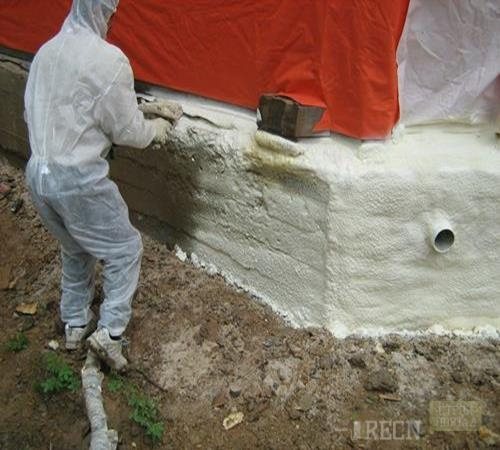

In conclusion, it should be noted that polyurethane foam is much more practical and convenient. The scope of its application is much wider, while it can be easily assembled independently. The only visible advantage of ecowool is the speed of work.
Another limitation relates to the operating mode. Foam rubber is neutral to fumes and high temperatures, and ecowool begins to decompose under the same conditions, as a result of which its fire-fighting properties practically disappear (use in baths, kitchens and boiler rooms is strictly prohibited).
Ekovata or penoizol
Ecowool is not the only seamless insulation, but only it has a natural organic basis. None of the heaters that can be poured, sprayed and even glued into the cavity of structures: walls, pitched roofs, floors and various ceilings has such a unique opportunity - to be identical in nature to a tree and become one with wooden structures. Let's consider an example of a choice: "ecowool or penoizol"?
The main raw material in the production of penoizol is urea-formaldehyde resin - hazard class 2 - a product of polycondensation of urea with formaldehyde. When pouring, Penoizol releases these formaldehydes - substances hazardous to human health. The polymerization process is not always irreversible. When heated, reverse processes are inevitable - the poisonous smoke of modern fires is caused precisely by the toxins of burning polymers. But the choice: "ecowool or penoizol?" You will have to do it yourself, although our clients prefer not to risk it when there is natural natural material and reliable installers from the Teploservice Company.
Which insulation is better, who to entrust the insulation
When choosing between price and quality, it is not always worth focusing on cost, but as usual there are exceptions: an unrealized newspaper simply cannot be expensive, and competition does its job.
Therefore, let the builders build, and it is better to trust the insulation to independent teams. And let the electrician - pull the wires, the roofer - cover the roof, the plumber - supply the water, and the eco-sensor, which uses insulation that is safe for human health, insulates the house. "What is better ecowool or mineral wool" or "ecowool or penoizol" is still up to the one who makes the choice between these materials.
Ecowool, disadvantages
If in the case of polyurethane foam everything is quite simple, then with ecowool it is necessary to understand in more detail. Experts talk about the following factors that negatively affect the choice in favor of this material:
- inability to use for external insulation,
- extremely short service life, which involves overhaul when replacing insulation,
- lack of a good distribution,
- the presence of low-quality products that do not meet the GOST,
- availability of products in violation of production technology.
The first two factors are not really significant, since in practice, internal insulation is found much more often, and repairs are done on average every 6-8 years. Nevertheless, the remaining ones indicate that ecowool is quite often not environmentally friendly at all and can be harmful to health, especially if used in a children's room.
In order to protect yourself from fakes, it is better to buy only goods from trusted manufacturers.

